Italian Grape Varieties
Almost half of the 350 known varieties currently no longer have any commercial significance. As a result of the progressive spread of international varieties such as Chardonnay, Sauvignon, Merlot, Syrah and Cabernet Sauvignon - even in Italy they are only present in small quantities. Many are struggling to survive. That's why vine researchers, politicians and winery owners are concerned about their country's 'ampelographic heritage,' according to Giuseppe Martelli, president of the Association of Italian Enologists and Cellar Technicians (Assoenologi). Preserving and researching the vineyard treasure is a high priority in the world's second-largest wine-producing country. Several governmental and private projects have been initiated to preserve the old autochthonous vines and to study them for their qualitative potential. The goal: to select the high quality varieties in order to promote more wines with reference to their origin, history, culture, and to be able to distinguish them from countless anonymous wines that today come mainly from Eastern European and overseas countries. 'Consumers expect wine to have a territorial identity,' Martelli puts it programmatically. After all, it is red wines from varieties such as Aglianico and Nero d'Avola from southern Italy, such as Sagrantino from Umbria, or such as South Tyrolean Lagrein that are already setting unmistakable accents in the wine world today. And Italy also has high-class, imitable white wines in its range, such as Greco, Fiano and Falanghina from Campania or Friulano (Tocai) and Ribolla from Friuli. Martelli: 'We already notice that the international markets honor Italy's efforts to produce high-quality wines from its own autochthonous grape varieties.'
The term autochthonous comes from the Greek and contains the word 'chton' = earth. Autochthonous therefore means 'native to the soil', 'originated on the spot'. Autochthonous vines are therefore native varieties that have been cultivated for a long time in a particular growing area of a particular region. They have adapted to the soil and climatic conditions. They have proven to give particularly good wine qualities in that particular area. Even more, the wine obtained from them has often given a face to the area. It has shaped its landscape (Valtellina, Alto Adige, Tuscany), has influenced its culture (craftsmanship, knowledge of nature, customs), has influenced art (as shown, for example, by the bacchanalian element in numerous Renaissance frescoes and paintings). The links between local wine and local cuisine (Barolo/truffles; Lambrusco/Mortadella; Vin Santo/Cantuccini; Lacryma Christi/Pizza) are particularly striking. Without wine and its rootedness in a particular place, many local dishes and specialties would probably have remained undiscovered until today. In other words, it is only when a territory is identified with a grape variety or a wine that one can speak of territorial identity. 'When you open a bottle of Chianti, you think of Tuscany', for example, says the booklet 'Vini Buoni d'Italia', according to its subtitle 'the first guide to autochthonous Italian grape varieties'. Similarly, one could say: Whoever has a Barolo in front of him feels transported to Piedmont or the Langhe. If you say Verdicchio, you mean the Marche. Who drinks Nero d'Avola, knows himself in Sicily. Who thinks of Primitivo, thinks of Apulia.
Many Italian grape varieties are for 200 years and longer in certain areas in cultivation. Is that enough to speak of being native? Or must a vine be proven for 1000, even 2000 years to be considered autochthonous? The question cannot be answered scientifically, nor can the problem be solved by legislative decree. What is decisive is that the variety has been present on the spot for a long time - in expert circles there is often talk of 200 years - and has held its own against all temptations to plant more marketable or fashionable varieties.
Autochthonous does not mean that the origin of the vines must also lie in the cultivation area itself, for which they are representative today. Often they have arrived there through detours. Moreover, we know that almost all the varieties grown in Italy originated in Greece. Greek and Phoenician merchants, when they settled the Mediterranean between 700 and 300 years BC, had brought them from their homeland and planted them in their new colonies in Sicily and in southern Italy. In 'Magna Graecia', as the colonies were then called, these vines found a new habitat and, provided they survived the natural selection process to the present day, mutated into varieties in their own right. - Gerardo [TS07/22]


